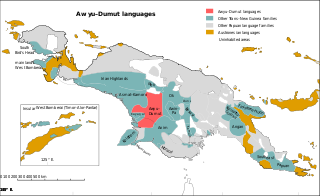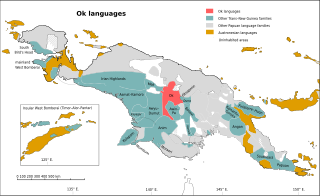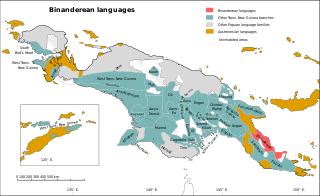Related Research Articles
The Sko or Skou languages are a small language family spoken by about 7000 people, mainly along the Vanimo coast of Sandaun Province in Papua New Guinea, with a few being inland from this area and at least one just across the border in the Indonesian province of Papua.
Kobon is a language of Papua New Guinea. It has somewhere around 90–120 verbs.
Isaka (I’saka) is the language spoken by the people of the villages of Krisa and Pasi in Sandaun Province, Papua New Guinea. It has also been referred to as Krisa, after the village, although this name is not actually a possible word in the language itself. The sole published source for the language is Donohue and San Roque (2004), although the authors of this have also Identified I’saka material in Donald Laycock's unpublished fieldnotes.

Porome, also known as Kibiri, is a Papuan language of southern Papua New Guinea.
The Ndu languages are the best known family of the Sepik languages of East Sepik Province in northern Papua New Guinea. Ndu is the word for 'man' in the languages that make up this group. The languages were first identified as a related family by Kirschbaum in 1922.

Oksapmin is a Trans–New Guinea language spoken in Oksapmin Rural LLG, Telefomin District, Sandaun, Papua New Guinea. The two principal dialects are distinct enough to cause some problems with mutual intelligibility.
Proto-Oceanic is a proto-language that historical linguists since Otto Dempwolff have reconstructed as the hypothetical common ancestor of the Oceanic subgroup of the Austronesian language family. Proto-Oceanic is a descendant of the Proto-Austronesian language (PAN), the common ancestor of the Austronesian languages.
Kara is an Austronesian language spoken by about 5,000 people in 1998 in the Kavieng District of New Ireland Province, Papua New Guinea.
May River Iwam, often simply referred to as Iwam, is a language of East Sepik Province, Papua New Guinea.

The Greater Awyu or Digul River languages, known in earlier classifications with more limited scope as Awyu–Dumut (Awyu–Ndumut), are a family of perhaps a dozen Trans–New Guinea languages spoken in eastern West Papua in the region of the Digul River. Six of the languages are sufficiently attested for a basic description; it is not clear how many of the additional names may be separate languages.

The Central and South New Guinea languages (CSNG) are a proposed family of Trans–New Guinea languages (TNG). They were part of Voorhoeve & McElhanon's original TNG proposal, but have been reduced in scope by half in the classification of Malcolm Ross. According to Ross, it is not clear if the pronoun similarities between the four remaining branches of Central and South New Guinea are retentions for proto-TNG forms or shared innovations defining a single branch of TNG. Voorhoeve argues independently for an Awyu–Ok relationship, and Foley echoes that Asmat may be closest to Awyu and Ok of the TNG languages. Regardless, the four individual branches of reduced Central and South New Guinea are themselves clearly valid families.

The Angan or Kratke Range languages are a family of the Trans–New Guinea languages in the classification of Malcolm Ross. The Angan languages are clearly valid as a family. They were first identified as such by J. Lloyd and A. Healey in 1968; Wurm (1975) classified them as Trans–New Guinea. Glottolog treats Angan as a separate or unclassified family, ignoring further evidence.

The Kamula–Elevala languages are a small family of the Trans–New Guinea languages spoken in the region of the Elevala River.

The Ok languages are a family of about a dozen related Trans–New Guinea languages spoken in a contiguous area of eastern Irian Jaya and western Papua New Guinea. The most numerous language is Ngalum, with some 20,000 speakers; the best known is probably Telefol.
The Huon languages are a language family, spoken on the Huon Peninsula of Papua New Guinea, that was classified within the original Trans–New Guinea (TNG) proposal, and William A. Foley considers their TNG identity to be established. They share with the Finisterre languages a small closed class of verbs taking pronominal object prefixes some of which are cognate across both families, strong morphological evidence that they are related.

The Greater Binanderean or Guhu-Oro languages are a language family spoken along the northeast coast of the Papuan Peninsula – the "Bird's Tail" of New Guinea – and appear to be a recent expansion from the north. They were classified as a branch of the Trans–New Guinea languages by Stephen Wurm (1975) and Malcolm Ross (2005), but removed by Timothy Usher (2020). The Binandere family proper is transparently valid; Ross connected it to the Guhu-Semane isolate based on pronominal evidence, and this has been confirmed by Smallhorn (2011). Proto-Binanderean has been reconstructed in Smallhorn (2011).
Tifal is an Ok language spoken in Papua New Guinea. Dialects are (1) Tifal (Tifalmin) and Urap (Urapmin) and (2) Atbal (Atbalmin).
Mian is an Ok language spoken in the Telefomin district of the Sandaun province in Papua New Guinea by the Mian people. It has some 3,500 speakers spread across two dialects: West Mian, with approximately 1,000 speakers in around Yapsiei, and East Mian, with approximately 2,500 speakers in and around Timeilmin, Temsakmin, Sokamin, Gubil, Fiak and Hotmin.
Safeyoka, or Ampale, is an Angan language of Papua New Guinea. Other names of this language include Ambari, Ampeeli, Ampeeli-Wojokeso, and Ampele. According to a 1980 census, there were around 2,390 native speakers. Commonly known as Ampale, the dialect is called Wojokeso. Speakers of Ampale range from the Waffa River to the Banir River, which is located in the northern part of Papua New Guinea. The Wojokeso dialect is spoken by people who live in five villages where multiple districts, the Kaiapit, Mumeng and Menyama come together in the Morobe Province.
Proto-Trans–New Guinea is the reconstructed proto-language ancestral to the Trans–New Guinea languages. Reconstructions have been proposed by Malcolm Ross and Andrew Pawley.
References
- ↑ Telefol at Ethnologue (18th ed., 2015) (subscription required)
- ↑ Golub, Alex (2007). "Ironies of Organization: Landowners, Land Registration, and Papua New Guinea's Mining and Petroleum Industry". Human Organization.
- 1 2 Telefol Organised Phonology Data, p. 1.
- ↑ Telefol Organized Phonology Data, p. 3.
- ↑ Healey (1964), p. 12
- ↑ "Phonotactic restrictions across prosodic domains" (PDF). Archived from the original (PDF) on 2008-09-05., p. 2.
- ↑ "Aspectual stem distinctions in the Mian verb".[ permanent dead link ], p. 1.
- ↑ Foley 1986, p. 146.
- ↑ Telefol counting
- ↑ Laycock, Donald (1975). "Observations on Number Systems and Semantics". In Wurm, Stephen (ed.). New Guinea Area Languages and Language Study, I: Papuan Languages and the New Guinea Linguistic Scene. Pacific Linguistics C-38. Canberra: Research School of Pacific Studies, Australian National University. p. 223.
- ↑ The Oksapmin Kinship System Archived 2009-09-20 at the Wayback Machine , retrieved May 21, 2009.
- ↑ Pawley, Andrew (2012). Hammarström, Harald; van den Heuvel, Wilco (eds.). "How reconstructable is proto Trans New Guinea? Problems, progress, prospects". History, Contact and Classification of Papuan Languages. Port Moresby, Papua New Guinea: Linguistic Society of Papua New Guinea (Language & Linguistics in Melanesia Special Issue 2012: Part I): 88–164. hdl:1885/38602. ISSN 0023-1959.